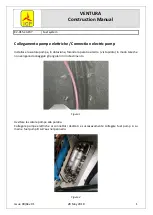
Airplane Flight
Manual Cessna
F
150
L
Nr. 160
Converted with kit
NS402S with ROTAX 912 S3 and
Page:
4-2
HOFFMANN HO-V352F/170FQ+10
Revision 1
– Change A
1
1)
Remove the gust lock.
2)
Magneto switch
„OFF”
3)
Main switch
„ON“ test the fuel pump and check fuel pressure. Then Main switch
OFF.
4)
Fuel valve
„ON”
2
1)
If rudder locked, remove the lock
2)
Check rudder for freedom of movement and security
3)
release the tie down
4)
Control surfaces freedom of movement and security
3
1)
Check aileron for freedom of movement and security.
4
1)
wing tie down release.
2)
Main tire check for proper inflation.
3)
Before first flight of the day and after each refueling, use sampler cup and drain
small quantity of fuel tank sum quick drain valve to check for water, sediment and
proper fuel grade.
4)
Check the fuel level visually and check fuel filler cap for tightness
5
1)
Check coolant level.
(See also ROTAX 912()
user’s manual). When checking
the coolant, the expansion tank must be full. The level in the overflow tank should
be between the min. and max. markings.
Warning: check or refill only when the engine is cold.
2)
Check the engine oil level with dipstick
(see. also, ROTAX 912 ()
user’s manu-
al). Before checking the oil level, run the engine for 1 min. At idle speed or turn the
propeller by hand a few turns to pump the engine oil completely out of the crank-
case. Stop the engine and check the oil level with the dipstick in the oil tank the oil
level in the oil tank should be at least between the two markings (max / min.) Of
the dipstick and must never fall below the min. Quantity difference between max
and min mark =
0
.
45
ltr.
Warning: Check only when the engine is hand warm!
3)
Pay attention to any kinds of leaks or abnormal noises
4)
Before the first flight of the day and after each refueling, pull the drain plug of the
fuel strainer for about 4 seconds to remove any water and debris from the strainer.
Check that the strainer outlet is properly closed again. If water is detected, there is
a possibility that the fuel system contains even more water and further fuel sam-
ples are to be taken from the fuel strainer, at the wing tank sumps and at the drain
plug of the fuel line.
5)
Check the propeller and spinner for notches, dents and security.
6)
Check the carburetor air filter for clogging by dust or other foreign material.
7)
Check nose wheel strut and tire for proper pressure.
8)
Release nose wheel tie down.
9)
Check the static pressure port on the left side of the fuselage for obstruction.
Содержание CESSNA 150
Страница 80: ...BLANK PAGE...
















































